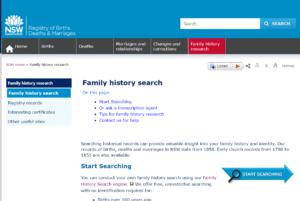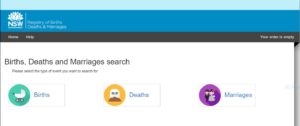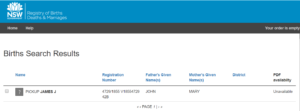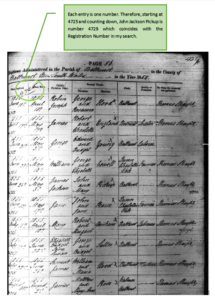THE THINGS YOU LEARN AT G.S.Q.
LOOKING FOR THE “J” IN JAMES J. PICKUP?
My research into the birth of James led me to the New South Wales Births Deaths and Marriages Family History Research page i.e. https://www.bdm.nsw.gov.au/Pages/family-history-research/family-history-search.aspx
- Just hit the “start searching” button.

- Select what your looking for a birth, a death or a marriage. In this instance a “birth”.

- Type in what you do know and a ballpark date. I searched for :
Name Fields>>James J. Pickup : Father>> John : Mother>> Mary : Date Range>>1829 – 1918
- Hit the search button (it’s free to search, however, these records do not contain the mother’s maiden name).
- What came up? Very simple, so far.

- Well, there was a James J. Pickup and probably my James Pickup but there was no District, so I wasn’t convinced. I decided to ask a G.S.Q. Research Assistant about the Registration Number. What could all those numbers mean and what could I do with them?
“Why, G.S.Q. has those records available to members for the price of a photocopy! You don’t need to purchase a certificate through New South Wales, Births, Deaths and Marriages”.
Needless to say, I was very impressed.
She explained: – Simply, this is a pre-registration baptism record.
Compulsory civil registration began in 1856 in New South Wales and as Queensland did not separate from New South Wales until 10 December 1859, this also applied in Queensland.
- “Okay, so what’s the process?”
- The drawers at the back of the Resource Centre contain many mysteries to me but this one is clear to me now.
The 4729 is the record number which was used to create the index (this can be very faded and is not always on each page) – so be patient.
The 1855 is the Baptism Year but not necessarily the birth year.
The V18554729 is the combination of the record number and the year.
The 42B (you can disregard the ‘B’) is the important one – it tells you which microfilm to search and is labelled on each box. Each tape of the microfilm has recorded on it baptisms, marriages and burials for a set time period – in that order and sometimes over two tapes, so it may not be on the first tape you search. “Can’t find it!” – check the date on the outside of the boxes and you may find you need to search the next tape.

- Use the Proscan (instructions available at G.S.Q. or simply ask one of the helpful volunteers).
- Searching the microfilm is not as simple as it would seem. The number I was looking for was not easily seen and patience was required but my search paid off – I found James J. Pickup’s birth date 3 May 1855 and baptism 24 June 1855.
- I had also set out to find out the occupation of James J. Pickup’s father – John Pickup – but alas it was not on either children’s baptism record or his marriage record. So that remains a mystery – but I did find the “J” stood for Jackson (his grandmother’s maiden name), that he was definitely born in Bathurst, and his exact birth and baptism dates and copies of records to prove it.
THAT’S JUST ONE OF THE REASONS I AM A MEMBER OF THE GENEALOGICAL SOCIETY OF QUEENSLAND.

Excellent article Lorri. These microfilms are a wonderfully under used asset of GSQ and unique to us. Hopefully they will be scanned as a priority to preserve for future members to appreciate as constant use is wearing and marking them.
Thanks Bobbie, Just when you think there are no clues to be found, these records are invaluable, as is the knowledge of many of our long serving and knowledgeable Library Assistants. Cheers Lorri
Great blog Lorraine, so glad you brought to attention this INCREDIBLE and underutilised resource! These are perhaps some of the MOST important records in all of Australia, containing original images of First Fleet baptisms, marriages and burials. I have to concus with Bobbie above – these should be a priority for GSQ to have digitally scanned so we can search through as PDF’s instead of using and reusing the microfilm. I have already seen whole maiden names scratched out. Joy Murrin has said herself, that what we have here is better than what they have in the NSW Registry – and that’s because we often have both copies of the original. At times you might see 2 results appear in the NSW online indexes, and this refers to two separate recordings of the marriage, baptism or burial. I encourage everyone to look at both, as they are often not exactly the same. Further to this, Lorraine the “B” on a volume actually refers to the “next” microfilm because sometimes the film roll ended and they began the next one to finish a volume. Therefore your 42B you needed would have been on the next roll. I can’t say enough about how important and vital these records are to GSQ as a resource to members, and perhaps as an income generator if we can get a partnership with Ancestry or FMP – let them do the digital scans with their advanced technology, and then GSQ can earn income each time someone pays for an image on that site. Thank you Lorraine! 🙂
Thanks Annalies, and thank you for clarifying the ‘B’ and you are quite correct it was on the second roll of film.
I agree, the records should be scanned and preserved in the most up-to-date manner available.
There is so much information which needs attention, but this falls upon the willing shoulders of ‘the few’. A
collaborative effort is required, perhaps something to be discussed at a M.C. Meeting? Cheers Lorraine
Yes totally agree, it’s a big job and there are so few who have the time to do it. Definitely needs to be a collaborative effort and maybe together with QFHS and some other QLD willing societies. State Library of QLD has a great community digitizing facility too…
Postscript – GSQ has now looked into the copyright of these films and it appears that sadly, the terms will not allow us to digitise the films.